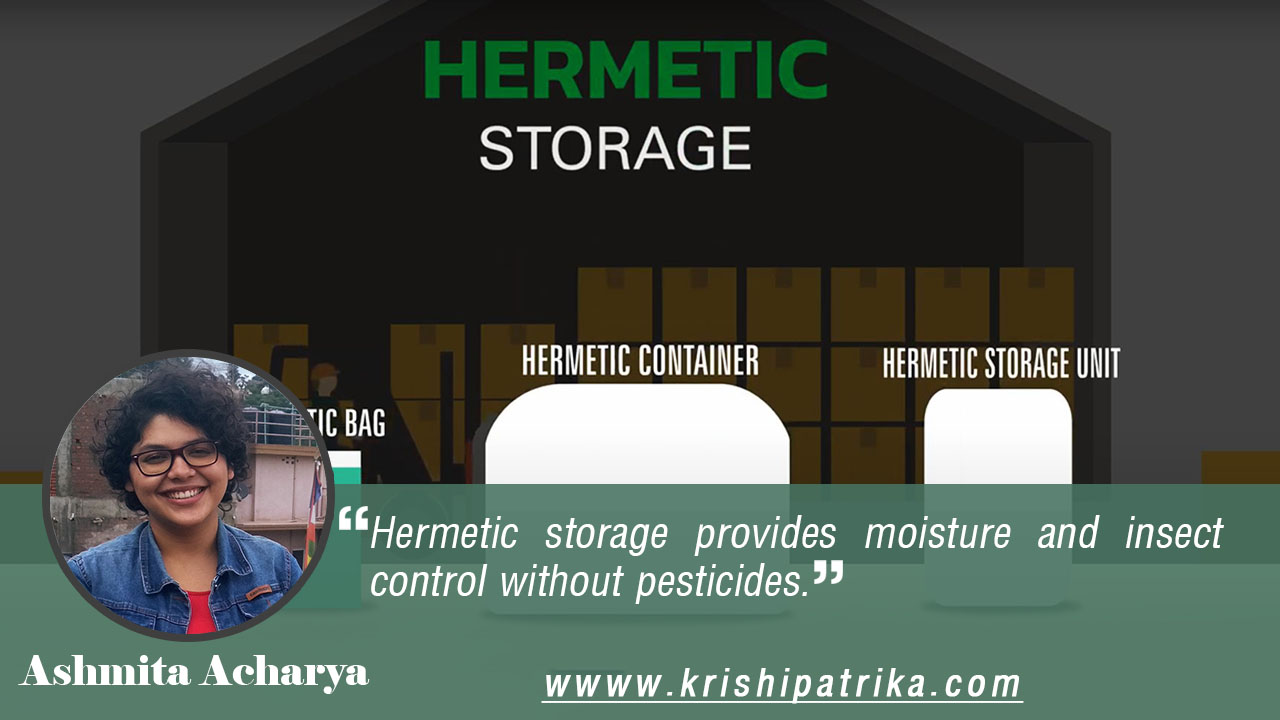
Hermetic Storage is a method of using sealed, airtight units to control moisture and insects in stored dry agricultural commodities. The hermetic storage restricts gas exchanges between the internal and external environments and the stored commodity, maintaining the initial levels of moisture and controlling pests by the lack of oxygen. Sealed or hermetic storage systems are a very effective means of controlling grain moisture content and insect activity for the stored grains.
By placing an airtight barrier between the grain and the outside atmosphere the moisture content of the stored grain will remain the same as when the storage was sealed. Biological activity inside the sealed container will consume the oxygen and as a result most insects will die. Hermetic storage provides moisture and insect control without pesticides. Different processes of utilizing the principal of hermetic storage include the use of IRRI Super Bag, Cocoon and use of local containers.
- IRRI Super Bag
The IRRI Super Bag makes the principle of hermetic storage available to farmers and processors at a very low cost. The IRRI Super Bag is a farmer-friendly storage bag that allows cereal grains and other crops (e.g., maize or coffee) to be safely stored for extended periods of time. The Super Bag fits as a liner inside existing storage bags (e.g., woven polypropylene or jute bags).
Sugar bags provide the following benefits:
- Extend the germination life of seed for planting from 6 to 12 months,
- Control insect grain pests (without using chemicals), and
- Improve the head rice recovery of stored grain typically by 10%.
Super bags reduce the flow of both oxygen and water between the stored grain or seed and the outside atmosphere. When properly sealed, respiration of grain and insects inside the bag reduce oxygen levels from 21% to 5%. This reduction reduces insects to less than 1 insect/kg of grain without using insecticides – often within 10 days of sealing.
The stability of controlled grain moisture inside the bag prevents wetting or drying of grain. This stability reduces the degree of grain cracking and so head rice recoveries are higher upon milling.
The super bag has currently designed to store up to around 50 kg of grain or seed.
Six steps for setting up a Super Bag is followed:
- Make sure that the grains or seeds are properly dried:
-
- Dry grain to less than 14%
- Dry seed to less than 12%
- Place the super bag inside an existing type of storage bag (e.g., woven polypropylene or jute bags).
- Fill the super bag with dried seeds or grains.
- Remove excess air. Close the opening by twisting the free plastic portion above the grain and fold it in two.
- Tie off the twist with a strong rubber band or adhesive tape
- Close the outer bag, taking care not to puncture the Super Bag.
- Cocoon
The Cocoon is a commercially available hermetic storage container that consists of two plastic halves that are joined together with an air-tight zipper after the cocoon is loaded with sacks of the commodity to be stored.
Cocoons provide the following benefits:
- Extend the germination life of seeds,
- Control insect grain pests without chemicals), and
- Improve the head rice recovery of stored grain.
Cocoons reduce the flow of both oxygen and water between the stored grain or seed and the outside atmosphere. When properly sealed, respiration of grain and insects inside the bag reduce oxygen levels from 21% to 5%. This reduction reduces live insects to less than 1 insect/kg of grain without using insecticides – often within 10 days of sealing. The stabilized moisture inside the cocoon prevents wetting and drying of grain, hence, reducing the extent of grain cracking and so head rice recoveries are higher upon milling.
They come in different sizes and configurations e.g. for bulk or bag storage. Some general guidelines for the application of cocoons include:
- Cleaning the seed or grain and drying to the correct moisture content. (seed 12%, grain 14%).
- Making sure the Cocoon is clean and undamaged.
- Sealing the Cocoon according to the manufacturer’s recommendation.
- Storing the containers either undercover or in the shade.
- Using an oxygen meter to measure oxygen content inside the cocoon, first daily and once the oxygen has dropped weekly to monitor that the Cocoon is properly sealed.
- Use of local containers
In rural settings there are often no supply chains yet allowing farmers access to the commercial solutions of IRRI bags and cocoons. In local markets there are often containers available that can be easily converted into a hermetic storage system and thus allowing farmers to benefit from hermetic storage even if they cannot buy the commercial solutions yet.
On principle any solid container that can be sealed air tight can be used. If the material is porous like that of a clay pot it needs to be sealed e.g. using latex paint in the inside and the outside.
Farmers should make sure to follow the steps below. If a container that previously contained chemicals is used then it should be cleaned thoroughly. The container should be free of any hokes or cracks. The following steps should be followed for the hermetic storage of grains through the use of local containers.
- The seed or grain should be cleaned and dried to the correct moisture content. (seed 12%, grain 14%).
- Seed or grain should be placed in the clean container.
- The container should be cleaned completely with seeds to avoid dead air space, the more air is inside the slower the oxygen drops.
- The container should be sealed air tight.
- When using a container with a screw top or press fitted closer grease or silicon should be used to seal the opening.
- When using clay pots or vessels made from porous material, the inside should be painted with paint and outside of the container with latex paint.
- The containers should be stored either undercover or in the shade.
- The container should be closed until you need to use the grain/seeds.
Intermittent opening and closing allows oxygen re-entry which can lead to the rapid re-infestation of insects that hatch from eggs or larvae. In containers that are only partially filled, the large air space to grain ratio may not allow oxygen levels to reduce to a level that will control insects. Hence, hermetic storage is an easy and dependable way of storing grains which can be applied easily even with the use of locally available containers. Farmers should be made aware of these type of storage mechanisms so that they avoid additional expenses on preserving seeds.









